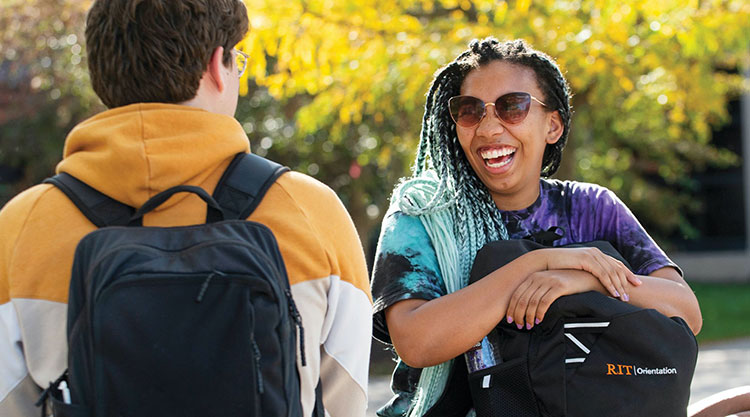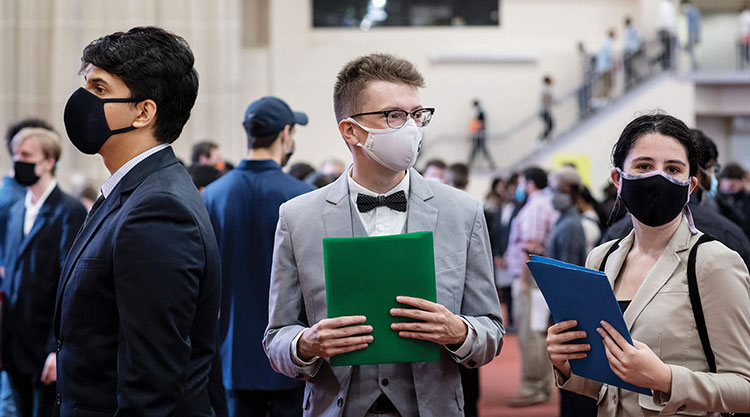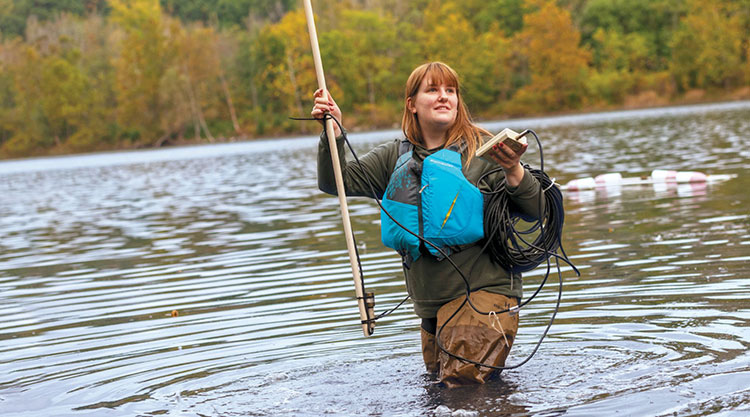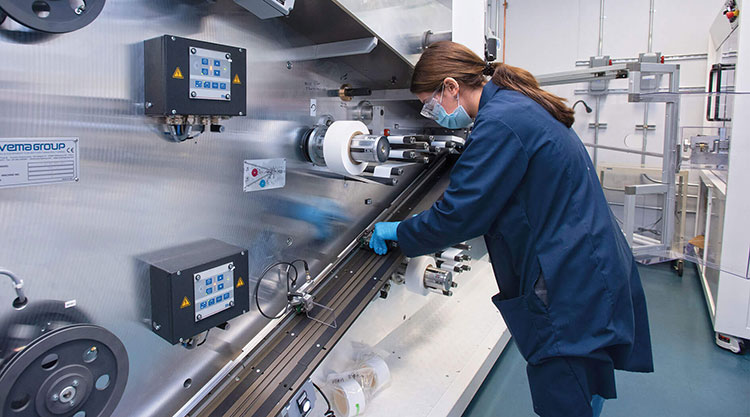-
![two students sitting outside and laughing.]()
Community of innovators hits record numbers
RIT’s community of students, faculty, staff, and alumni has grown larger than ever. Enrollment jumped to a new record last fall with 19,718 students studying across all campuses, up 1,050 from fall 2020.
-
![student performing traditional Indian dance.]()
Performing artists take center stage at RIT
RIT is well on its way to developing the leading performing arts program in the nation for non-majors, attracting talented and creative students who can continue their passions for music, dance, theater, and other performing arts.
-
![student working on a dress pattern.]()
Students build businesses during gap year
Gap Year Entrepreneurship Fellowships allow students to take time off from classes to focus on their growing business, new product, or compelling social innovation opportunity. In addition to the finances, RIT supports the students with mentoring and progress toward a degree.
-
![logo for the National Science Foundation.]()
Scholars earn coveted early career awards
Three faculty members who chose to start their research careers at RIT received prestigious National Science Foundation CAREER Awards in 2021. Their research aims to advance the foundations of machine intelligence, artificial intelligence, and clean energy.
-
![environmental portrait of professor Jeyhan Kartaltepe in front of images of space.]()
Professor helms program for NASA’s newest space telescope
When the James Webb Space Telescope (JWST)—the long-awaited successor to the Hubble Space Telescope—becomes operational this year, Jeyhan Kartaltepe will co-lead a team of nearly 50 researchers to map the earliest structures of the universe.
-
![environmental portrait of professor Blanca Lapizco-Encinas.]()
Biomedical engineering professor influencing next generation
As an expert in microfluidic devices—tiny labs able to decipher bioparticles—Blanca Lapizco-Encinas and her research partners uncovered a mystery in how these particles can be better differentiated. As she has moved her own research forward, she is influencing a new generation of scientists to do the same.
-
![Sstudent cybersecurity team huddling around two computer screens.]()
Students take home top prizes at collegiate competitions
For RIT students, the learning doesn’t stop when classes end. In 2021, three student teams took what they’re learning and used it to win national and international competitions in cybersecurity, racing, and design.
By the Numbers
4,594
RIT awarded 4,594 associate degrees, bachelor’s degrees, master’s degrees, Ph.D.s, certificates, and advanced certificates in the 2020-2021 academic year.
970
Last fall, RIT enrolled 970 deaf/hard-of- hearing students—441 at NTID and the rest spread out among RIT’s other colleges and degree-granting institutes.
5,180
RIT’s largest college, Golisano College of Computing and Information Sciences, enrolled 5,180 students.
1.73M
There have been 1,733,512 total RITx course enrollments on the massive open online course platform edX. RITx has awarded 1,488 MicroMasters program certificates.
-
![student using pipette as researcher looks on.]()
Undergraduate research on the rise
With the help of strong mentors, undergraduate researchers cultivate critical thinking, collaboration, and problem-solving skills. Conducting research can help students synthesize concepts they learned in their classes to create something new.
-
![students waiting in line at a career fair.]()
Co-ops give students edge in job market
More than 5,000 RIT students receive experiential learning by completing a co-op each year, often getting a foot in the door to a new career upon graduation. Started in 1912, RIT’s successful co-op program, one of the oldest in the nation, is also a resource for companies wanting skilled RIT students to work for them.
-
![student wearing sensors on her head adjusts a robotic arm.]()
AI research collaboration begins
Cecilia Alm, an associate professor in RIT’s College of Liberal Arts, was awarded nearly $2 million by the National Science Foundation to lead a team of RIT faculty addressing a lack of diversity in the artificial intelligence research community and gaps in AI curricula.
-
![researcher with different samples of organic materials called biochar.]()
RIT expands Ph.D. portfolio
RIT’s strategic plan calls for adding six to 12 new Ph.D. programs and conferring 50 doctoral degrees every year by 2025. The university already reached the latter goal with 51 Ph.D. degrees conferred in the 2020-2021 academic year.
-
![student walking a runway wearing a piece that features black fabric and white chain-like structures.]()
Technology blurs the line of making in arts programs
In virtually every art course and studio environment at RIT, technology is integral to the delivery of content and production of work, whether it’s an “ancient” technology like using a hammer and anvil to forge metal or a computer numerical control plasma table to cut metal forms.
-
![students in a classroom.]()
Saunders College of Business offers STEM-designated programs
Six graduate programs in Saunders College are now STEM-designated, allowing students the opportunity to engage in technology-based business education.
-
![crane putting support beams into place on a building construction project.]()
Makerspace complex will transform center of campus
The largest construction project on the RIT campus in more than 50 years remains on track to open in fall 2023. When complete, the Student Hall for Exploration and Development (SHED) will cover more than 120,000 square feet of new construction as well as more than 83,000 square feet of renovations in two existing buildings.
-
![student research in waders in a lake with a pole and a measuring device.]()
Tait Preserve becoming hotbed for research
RIT has an emerging new hotspot for interdisciplinary research about 25 minutes from the main campus. The Tait Preserve includes a 60-acre lake and a private mile of Irondequoit Creek adjacent to Ellison Park, offering endless opportunities for research, education, and conservation activities.
-
![artist rendering of the exterior of a performing arts space.]()
Performing arts complex debuts in 2024
With thousands of RIT students involved in performing arts expected in the next few years, plans are moving forward for a performing arts complex that will feature a 750-seat theater and eventually a 1,500-seat orchestra hall for larger audiences.
-
![artist rendering of the exterior of a brick academic building.]()
Gifts make Saunders College expansion possible
RIT business students can expect major changes to Max Lowenthal Hall, home of Saunders College of Business, after the completion of a more than $20 million expansion and renovation project in fall 2023.
-
![people in an art gallery looking at jewelry and prints.]()
Initiatives helping drive downtown resurgence
RIT is contributing to Rochester’s revitalization efforts in a significant way, bringing a creative energy and economic development acumen translating into important arts, cultural, educational, and economic opportunities for the city.
-
![students waiting at a half-wall to borrow photo equipment.]()
Updates meet growing photo demands
The extensive renovation of RIT’s College of Art and Design—with keen focuses on key areas within the internationally recognized School of Photographic Arts and Sciences (SPAS) and School of Film and Animation—made significant strides in 2021.
-
![arist rendering of a stadium and field.]()
Athletic facility improvements in home stretch
RIT's outdoor athletic fields, including the outdoor track and baseball and softball fields, are getting a facelift. Next up: the installation of a state-of-the-art artificial turf field as well as the construction of a full stadium complex.
-
![group of men walking on the campus of RIT Dubai.]()
Global campuses celebrate milestones
While students have engaged in virtual international experiences throughout the pandemic, they once again began crisscrossing the globe last fall for in-person international education experiences.
-
![student researcher adjusts equipment that makes batteries.]()
Battery Prototyping Center doubles capacity to serve clients
Since opening six years ago, RIT’s Battery Prototyping Center has nearly doubled its research and development projects with battery manufacturers from Boston to Silicon Valley. More industries are exploring designs for commercial quality lithium-ion batteries and seeking experts at the center to provide research about the development of different styles of batteries.
-
![dance instructor looks on as students practice.]()
Garth Fagan Dance partnership opens with a spirited first act
RIT students are already benefitting from a new partnership with Garth Fagan Dance. RIT Performing Arts Scholars Program students are taking master classes and students are working on a semester-long arts management capstone project to deliver suggestions for the internationally known dance company to potentially implement.
-
![film crew shooting a scene with an astronaut meeting an alien on the moon.]()
MAGIC alliances prove mutually beneficial
RIT’s MAGIC Center won a MegaGrant from Epic Games, the largest academic grant ever awarded by the industry’s leading game engine developer. The grant allows professors to participate in hands-on training with some of the world’s leading visualization and virtual production experts.
by-the-numbers
Enrollment By the Numbers
Last fall, RIT enrolled a record 19,718 students, up more than 5 percent from the previous year.
Enrollment at RIT’s global campuses in China, Croatia, Dubai, and Kosovo continues to grow steadily and has more than doubled in 10 years.
RIT is prioritizing increasing enrollment of African American, Latino American, and Native American (AALANA) students.
Excludes global campuses.
Last fall, RIT had 1,896 students from more than 100 countries outside the United States enrolled at its main campus. These are the top five counties outside the U.S. that RIT students came from.
RIT’s main campus enrolled 14,055 undergraduate students and 2,819 graduate students last fall across nine colleges and two degree-granting institutions.
Research By the Numbers
RIT’s sponsored research awards surpassed $76 million for the 2020-2021 fiscal year, another significant milestone in spite of the challenges posed to research efforts brought about by the COVID-19 pandemic.
In
millions of dollars
Based on the NSF Higher Education Research and Development (HERD) Rankings, which ranks universities based on their research expenditures, RIT is now in the top 50 private research universities and the top 20 for those universities
without a medical center.
In millions of dollars
* Estimated
Researchers submitted a record number of proposals in fiscal year 2021.
The federal government awarded more than $38 million during the 2020-2021 fiscal year.
*All other federal agencies, such as Agriculture, Justice, and Labor.
The number of Ph.D. degrees awarded has gone up each year over the past five years, and last May RIT awarded its first Ph.D. in electrical and computing engineering.
Alumni By the Numbers
Total philanthropic giving in fiscal year 2021: $31,162,182
*Includes students, friends, former faculty/staff, and parents
Top five locations outside the U.S.
More than 150,000 people have graduated from RIT since 1926.




































